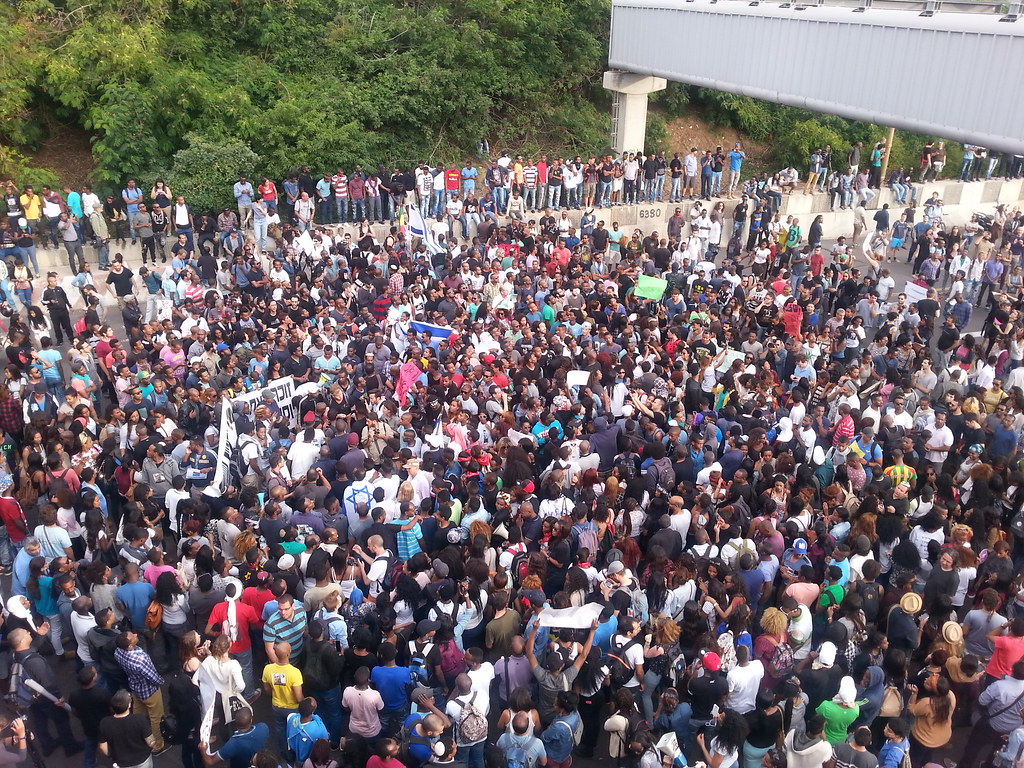Several days of demonstrations turned violent throughout the country. Roads were blocked for hours, property destroyed, and claims were made that Ethiopians had murdered police.
It began in response to an occurrence in a public park, when an off-duty policeman approached a group of young men quarreling. Indications are that they threw stones at him that caused injury, and that he fired his gun at the ground, which ricocheted and killed an Ethiopian.
What began with that turned into a mess of claims. The man killed was 18 or 19, but we heard from protesters that he was a kid, perhaps 14, who was murdered in cold blood by a cop.
A unit of the Justice Department investigated the incident, while the policeman and his family were identified on the web and sent to a secret location in response to fears for his life.
What transpired recalls widespread waves of urban rioting in the United States, especially by African Americans, after incidents of killing by police.
For two days the police responded gently, letting Ethiopians and their allies close main roads for hours. Ambulances, those invited to weddings, and all others were tied up for a full evening. Citizens’ cars and police cars were overturned and set on fire.
While many of the protesters were Ethiopians, whites also participated, some perhaps enjoying an opportunity to create chaos. There were unconfirmed charges that the New Israel Fund, a left of center body supported by overseas Jews, was funding the demonstration. Yair Netanyahu said that Germans supported the demonstration.
By the third day, police indicated that they would not allow demonstrators to close roads, and by then pictures of the action indicated that the majority of demonstrators were not Ethiopian.
The family of the slain individual called for calm, and protested the violence.
In the commotion, perhaps 60 demonstrators were injured, as were a number of police. Some were arrested for causing violence.
For several days, there was little else on the news, and much of the country came to a stop.
Ethiopians came to Israel largely in two waves. Operation Moses occurred in 1984 and Operation Solomon in 1991. Both occurred with government financing, and some quarrels as to whether the individuals involved were actually Jews. Officially the issue was solved by a decision by the Rabbi heading SHAS, but the issue remained with the Rabbinate requiring a degree of conversion and insistence that the Ethiopians remain religious.
Currently there are perhaps 150,000 Jews with Ethiopian origins in Israel. Individuals have advanced through higher education into medicine, the officer corps of the IDF, police, the Knesset, and other indications of professional advancement. However, many remain concentrated in what activists call “ghettos.” They also reside throughout the country. We see Ethiopian kids in the next door schoolyard where my wife and I live in French Hill.
Since 1991 there have been occasional movements of other Ethiopians, who claim relationships with those in Israel, from camps in Ethiopia operated by overseas Jewish organizations. There have been questions about the Jewishness of these migrants, and the permission for their movement has been sporadic and involved in Israeli politics.
There also have been several instances of protest surrounding decisions of the Health Ministry with respect to accepting blood donations from people born in Ethiopia, and charges of racism among the police.
Incarceration at something like three times the incidence of other Israelis has occurred among Ethiopians charged with crime, as well as a high incidence of IDF Ethiopian recruits imprisoned in military facilities.
It recalls the history of Moroccans, who found themselves incarcerated at high incidence, and gave rise to protests years ago under the heading of Black Panthers..
It has been common in both cases to accuse Israelis of racism. True? Exaggerated?
No doubt there is some truth to the claim, but also an incidence of group think and exaggeration toward violence by some Ethiopians and non-Ethiopians in response to incidents that may or may not reflect racism.
Individual schools have refused to accept Ethiopian students. Individuals with a choice have selected to be served by non-Ethiopian rather than Ethiopian physicians. Military officers have separated Ethiopian recruits from others.
The media is understanding, or even supportive of the demonstrators.
We hear that the absorption of Ethiopians is a failure marked by ghettos, exclusions, discrimination, and a high incidence of criminality and incarceration.
Young men who have finished their army service reported that they had been called to jobs, but when they showed up, were told that there were none.
Those wanting data about Ethiopian poverty, and progress in recent years, can click on this.
Is this more or less than police and other actions against African Americans, or what occurs against minorities in Europe? It is hard to tell given the differences in numbers and incidents, as well as the histories in each place.
Some expected a renewal of protests this week. However, the concern with Ethiopians seems to have been taken over by concern with the wretched behavior of a teacher at an infants’ school. A day after details of her behavior were made public, someone burned her home. Demonstrations followed throughout the country, demanding more control over infant care centers.
It’s difficult to keep track of our problems.
Republished from San Diego Jewish World


























